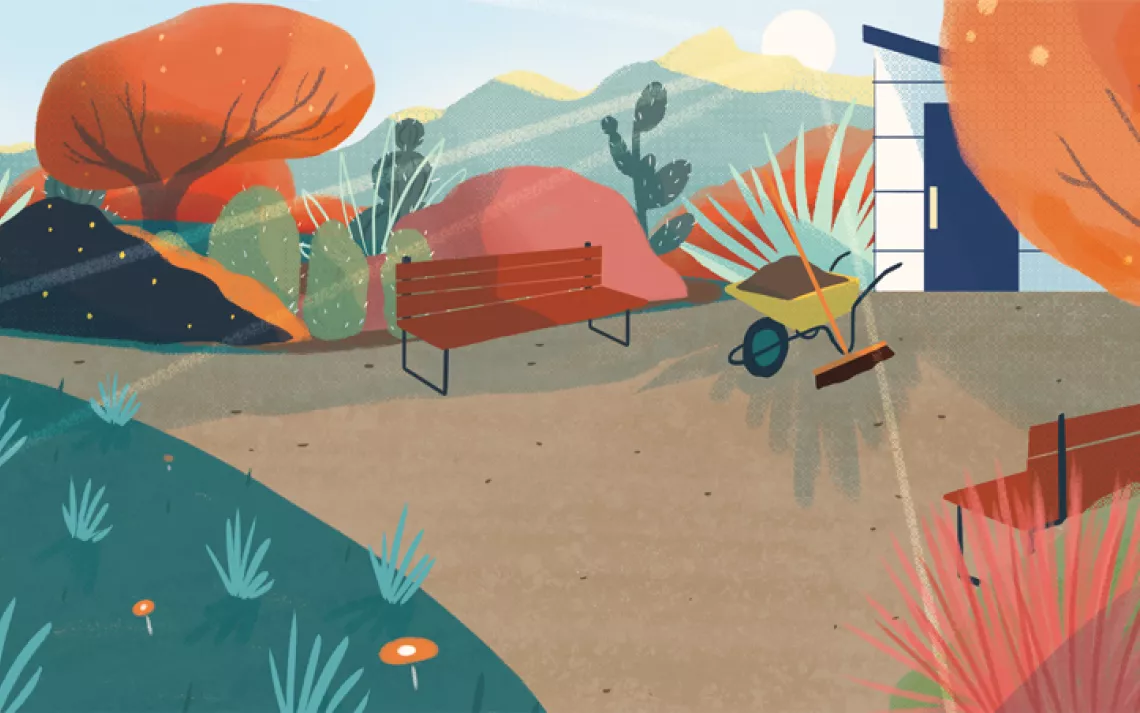Give Your Landscape a Carbon-Positive Makeover
Here are seven ways to sequester more carbon than you generate
Illustration by Rachel Tunstall

Are you already planting native species and using water-conserving drip irrigation in your yard? Fantastic. Take things to the next level by designing your home landscape to be carbon-positive—meaning that it sequesters, or removes, more carbon dioxide than it generates. For instance, consider planting a large tree. It could remove hundreds of pounds of carbon from the atmosphere over its lifetime. Conversely, adding a patio could add hundreds of pounds of carbon, depending on the footprint of the materials you use. Here's how to create a truly green landscape.
Give your landscaping a carbon audit.
To suss out the main carbon-generating culprits—and sequestering heroes—in your current landscaping, enter details about hardscaping, plants, and maintenance equipment into the free carbon calculator at climatepositivedesign.com/pathfinder. (Stone pavers, for example, score poorly because of the intense amount of energy required to cut and transport them.) Created by landscape architect Pamela Conrad, the tool was designed for professionals but works just as well for homeowners. You can also download the Climate Positive Design Toolkit, which lists 50 strategies for improving your landscape's footprint; for instance, plant bamboo to sequester carbon dioxide.
Avoid using concrete.
Whether you pour concrete for a walkway or pave a patio with it, you are using what is essentially artificial rock, and that increases your garden's environmental footprint dramatically. Concrete is produced with cement, which has to be heated to 2,500°F in the course of its manufacturing. Instead, use decomposed granite or gravel to create paths and patios. One option for driveways is a permeable paving system that holds gravel in place, like Truegrid (truegridpaver.com), which is made from postconsumer recycled plastic and allows rainwater to drain into the ground.
Rethink the high-maintenance lawn.
Lawns are notorious resource guzzlers that require frequent mowing and heavy irrigation. Landscape architect Sarah Sutton, author of The New American Front Yard: Kiss Your Grass Goodbye, likes to turn front yards into outdoor rooms with seating areas. Her advice: "Reclaim the space so you don't have to do everything in the backyard." For the millions of Americans who are required to have a lawn because of homeowners' association requirements, Sutton recommends using low-growing fescues (often sold as a "no-mow lawn seed mix"), buffalo grass, or the ground cover kurapia (Lippia nodiflora). For more options, head to stepables.com—browse photos and find the best lawn substitutes for your hardiness zone.
Plant trees.
To substantially increase your yard's carbon-capturing capability, add trees—the bigger, the better. "Look for the largest, most long-lived species that is adapted to your area, and make sure it has the space to grow to its mature size to avoid constant pruning," says San Francisco arborist Allegra Mautner of Prune Buggy. She recommends planting younger seedlings rather than full-grown trees: "If it gets started as a smaller plant, it will better adapt to your yard." Use i-Tree Design (design.itreetools.org), a tool provided by the US Forest Service, to estimate your tree's carbon-sequestration power along with the energy savings from its shade and other benefits.
Research native flora.
A landscape of native plants, which have adapted to flourish without much intervention, will give your yard a more local aesthetic and save you the maintenance of a traditional garden. But natives aren't always easy to find at big-box garden stores. Fortunately, each state has a native-plant society that can help you figure out the best plants and where to buy them. (In California, for instance, go to calscape.org and type in your address to find truly local natives.) Go to plantnative.org for a nationwide directory of nurseries.
Skip the commercial fertilizer.
Most fertilizers contain synthetic nitrogen, which requires a lot of energy to produce. Once the fertilizer is applied, the sudden large burst of nitrogen feeds the plants but also stimulates soil microbes to produce extra amounts of nitrous oxide, a potent greenhouse gas. "Whatever the plant doesn't need is going into the rest of the environment," says Philip Robertson, a professor of ecosystem science at Michigan State University. In most cases, you can use a sparing amount of an organic slow-release fertilizer like compost to keep plants healthy and boost yield.
Make a sweeping change.
Gas-powered leaf blowers rely on fossil fuel, contribute to air pollution, and drive the neighbors crazy. Why not meditate on the beauty of nature while sweeping leaves instead? A good broom, like the Heavy-Duty Garden and Garage Broom ($39) from garden tools specialist Garrett Wade, can make it less of a chore.
This article appeared in the March/April edition with the headline "The Path to Carbon-Positive Landscaping."
 The Magazine of The Sierra Club
The Magazine of The Sierra Club



